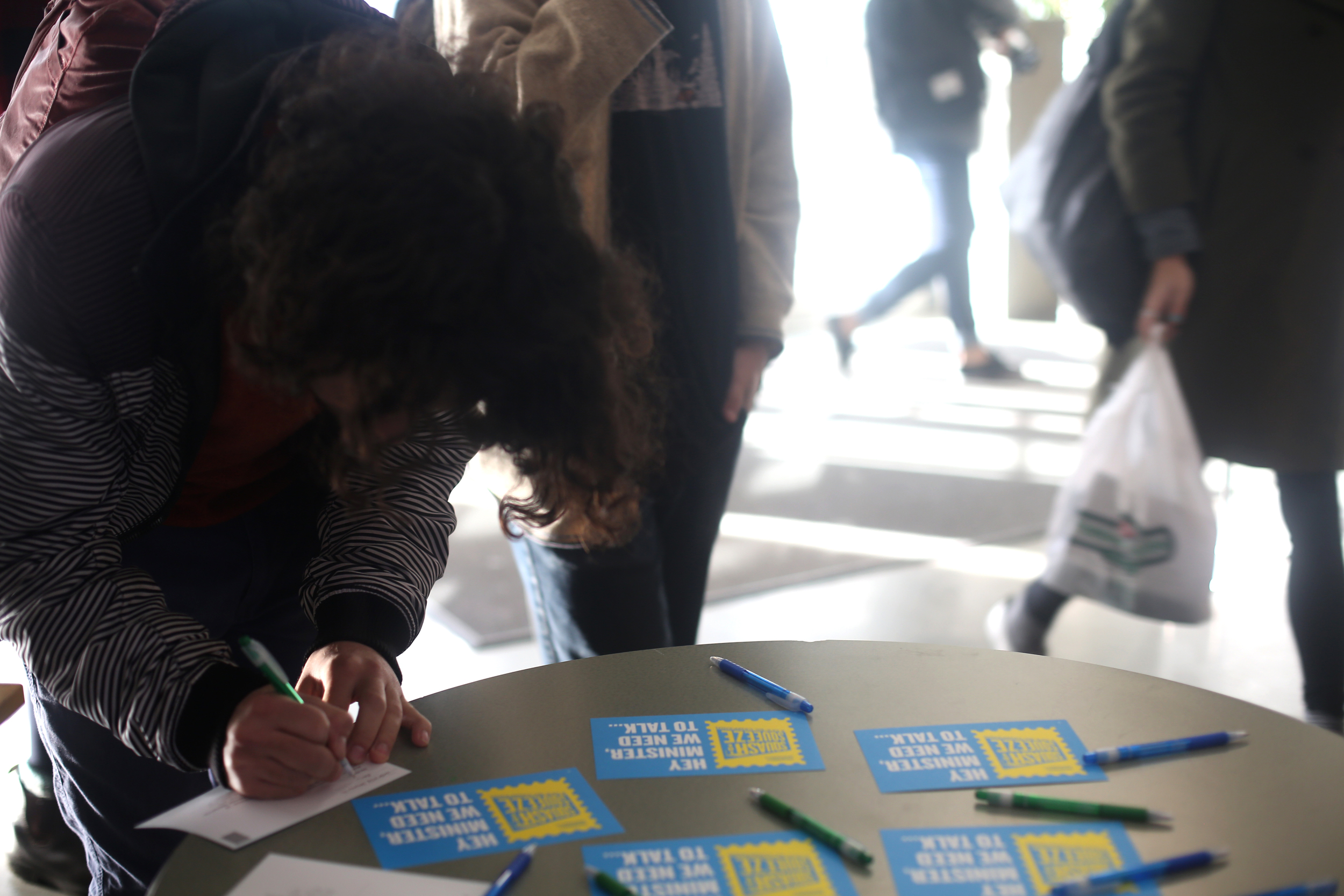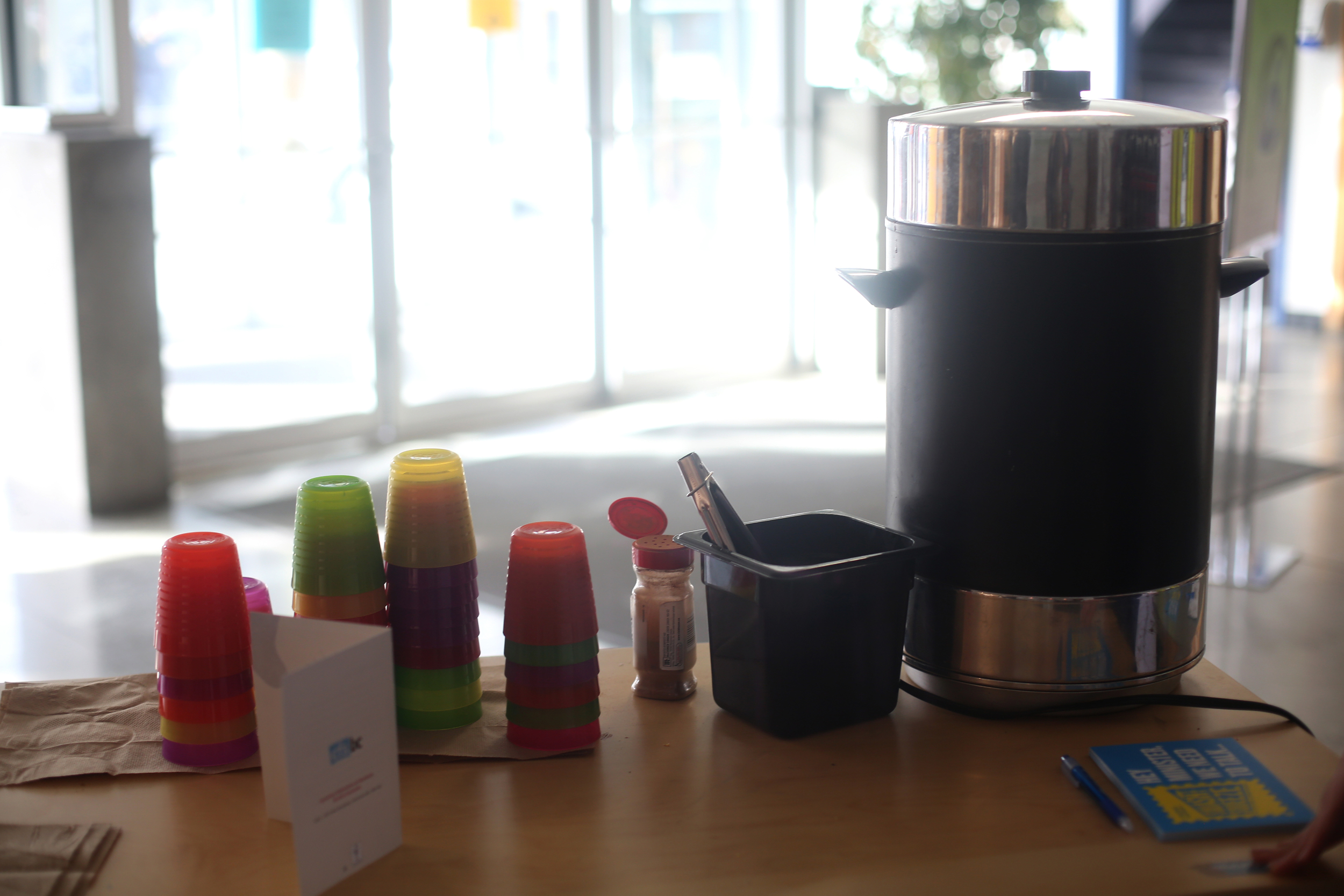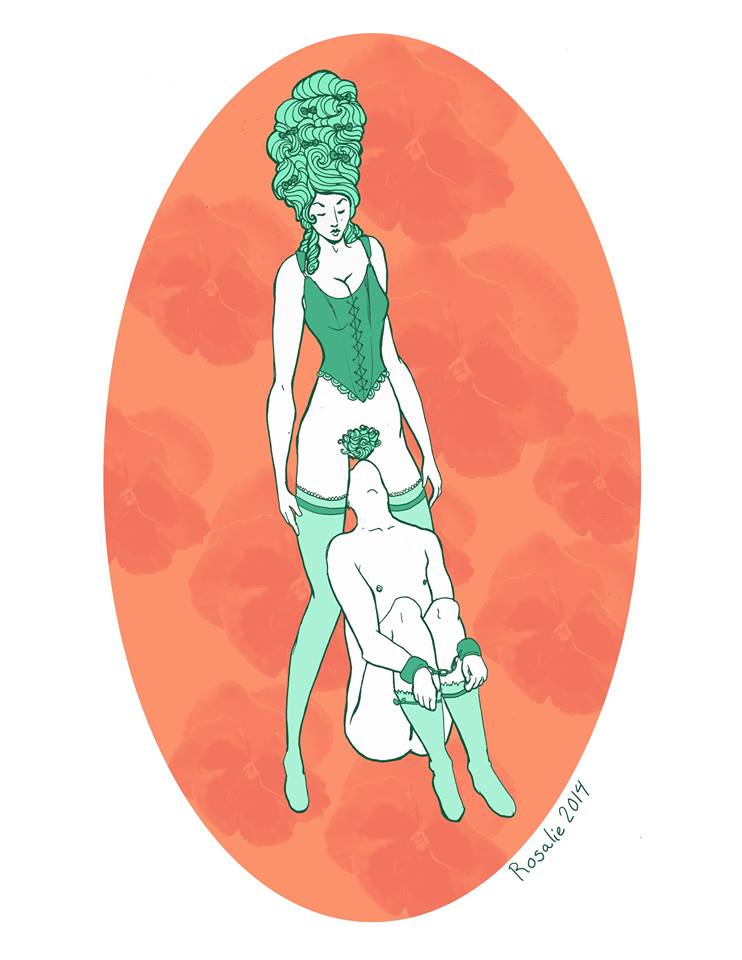The Debacle of the Capilano University Studio Art Closure
The following is a report from former Capilano and current Emily Carr student Jennifer O'Keefe. It outlines her experience and investigation into the Capilano programs closure of the studio art program last year. It is important that as this political and highly contested event disappears from our newsfeeds that investigation and analyses of how this continues to affect the climate of artists and students in Vancouver persists.
JD.
From the very beginning it became evident that the University administration seemed to care very little for the students and faculty of the programs axed.
The announcement of cuts occurred 3 days before the end of term 2013: our coordinator, under gag order by the admin, leaked it to all the students and staff that our program was going to be cut, apparently the admin wanted her to wait until their graduation to break the news! The timing of this came too late for many of the students to apply to other institutions (students feared that they would not be able to graduate because of the cuts ), it was also too late for many faculty to find jobs at other institutions. Most of the students and staff were crying when the news broke, we then started delegating tasks and organizing how we were going to try and save the program.
Originally one of the explanations given to us by the admin, was that the University had a budget deficit of $ 1.3 that was being incurred by the programs, however after I started reviewing the audits and the revenue that programs were generating, it became evident that this wasn't really the case.
To cover a 1% shortfall, the University was cutting $3.1 million in programs, cancelling 211 courses, and cutting entire programs without a clearly stated plan. I started to question if the deficit was a result of financial mismanagement of the University’s finances. I filed Freedom of Information requests with Michaela Hanemaayer for administrative travel expenses and spent a lot of time reading through the University’s audits, and there were definitely some questionable things occurring in regards to the financial management of the institution.”
Here is some of the information gained in our FOI requests:
Over her last four years, Capilano University VP Catherine Vertesi has spent $276,692 on travel costs. She spent $79,651.43 for 2011 alone, including a side trip to Paris! Coincidentally, she just happens to be former Premier Gordon Campbell's sister.
Catherine Vertesi's travel expenses:
2011 $74,739.59
2010 $55,600.18
2009 $66,701.06
in 2006-2013 Cindy Turner spent $21,464.00
There is also considerable circumstantial evidence suggesting that Cap had been subsidizing international student tuition. - Subsidizing international student tuition is against Provincial Mandate.
Thus, Catherine Vertisi's travel expenses over those four years amounts to approximately 20% of the budget-shortfall of $1.3 million. For one individual to be incurring such extravagant expenses when the University is obviously experiencing significant economic difficulties is utterly unacceptable. Further, given the apparent climate of entitlement that seems to pervade the administration at Capilano, it is hardly surprising that they have mismanaged the University's finances to such an extent that the very programs that have historically constituted the essence of the University ( Studio Arts, et al ) have
been eliminated. To sum, the future of education has been compromised by incompetence and corruption of the people entrusted to oversee the institution.
Juan Cisnero, Melissa O’Connor, Michaela Hanemaayer and I became largely responsible for writing and distributing the petitions to the Government, Board and President asking them to save the program; students sent out crews to gather signatures from the campus and the community of North Vancouver, eventually we received over 7000 signatures.
I organized a silent sit-in protest to take place in the presidents office April 29th 2013. However this was sidelined; instead, more than 100 students and faculty were crowded into the lecture hall to meet with Kris Bulcroft (who was sitting on a chair onstage), Keirnon Simmons the school conflict resolution advisor mediated the affair. Each student was expected to go up individually in order to speak (while having their faces videotaped by the admin! ). In response, the film students decided that it was only fair that the administration should also be filmed (videos of the meeting are on youtube). At one point I went up to speak and said “ We, the students are requesting an independent audit of the University, to ascertain the extent of the deficit as we have reason to believe the deficit is due to financial mismanagement. We would also like some budget transparency: travel costs and expenditures by the administration, are the trips at the costs of students and taxpayers. We question the shifting of resources making the university more attractive to international students and by so doing, the admin has chosen to deny education opportunities to existing and future students”. ( prior to the meeting I had been reviewing the Public sector database, and had been somewhat alarmed by the amount of expenses being claimed by certain VP’s! ) At the meeting, students asked if they were including faculty severance packages for the cut programs, in the deficit, to which they replied yes, when asked further regarding what the cost of this was, they stated that severance packages were roughly around $600,000, but that they did not know for sure, because some faculty might choose to take early retirement instead. To be clear, this meant that they were including the severance pay of the soon to be laid-off faculty in the $1.3 million dollar projected deficit (?!) At the same meeting faculty had offered to pool together money and fundraise to bail the University out of its deficit as it was the equivalent to the price of a house, however Kris Bulcroft talked about how they had not given up on getting adequate government funding. After which I asked “ But even if you had the funding, would you keep the programs?” Her response was “ that’s a good question, we have to continue this dialogue, that she didn't know enough about the programs and their longterm sustainability. After further questioning she said, “No, she wouldn't keep the programs”.
You can imagine what the reaction to this statement was!
Video : https://www.youtube.com/watch?v=B2oXlOBL54I
After more research in the library archives Michaela and I stumbled upon the ‘Conceptual Development Plan’ for the University, a very interesting document that discussed international student housing in the northern part of the campus. (The Studio Art Building, the Jazz building and the parking lots were also in the yellow zone for future redevelopment?). I was later sent a video of the North Vancouver District Council meeting where the admin had introduced the plan. When questioned by the District Council about how they planned to fund the projects, they said that they had no funds. (?!) Why would the administration spend $76,462 on a plan which they had no known budget to work with?
http://www.dnv.org/upload/documents/Council_Agendas_Minutes/121119RC_MIN.htm
What bothered me the most about this whole process is the fact that while all these things were happening, very few people actually seem to stop and question! When you see something that’s not right, or the numbers don't add up, doesn't that make you want to get out there and try to find out what exactly is wrong?
Needless to say, Michaela and I spent rather a lot of time researching, trying to find answers as it seemed that all the faculty, students and community were being stonewalled by the administration, with little transparency into the processes at Capilano University.
On June 11th the Board of Governors voted to cut programs despite public and community outrage, and letters of support from artist Gordon Smith, who begged the board to reconsider! Letters from Emily Carr University faculty spoke of how the Studio Art program was invaluable to the Arts and Culture of B.C. At the meeting the Board also refused to look at the CFA alternative budget, which would have balanced the entire budget without making drastic cuts!
On July 31st 2013 Michaela and I, filed a freedom of information request against the administration at Capilano University.
In September, 2013, Michaela and I had an opportunity to meet Opposition Education Critic David Eby. I asked him if he would be willing to look at some of the University audits that I had accumulated, and told him that we had copies of the audits and some information that we would like to show him regarding the FOI Request.
It wasn't until around Oct that we were given the remainder of the contents for the FOI request, we were unable to get everything that was originally asked for - specifically, full extent of VP Catherine Vertesi’s travel expenses.
We eventually had a meeting with David Eby, where he looked at the audits and our FOI requests, listened to our concerns and questions regarding what appeared to be rather extravagant travel expenses for VPs, and what also appeared to be the subsidization of international student tuition. He considered the information interesting, and suggested some very helpful advice regarding information to look for and told us about the Ombudsperson. It wasn’t until later, when he started investigating Kwantlen and exposing the Amrik Virk scandal, that he found there was a similar pattern at Capilano University in regards to executive overpayment.
I ended up filing a complaint with the Ombudsperson asking them to investigate expenditures by the administration (VP Catherine Vertesi ), and the suggestion - gleaned from the notes and minutes - suggesting Capilano had been subsidizing international student tuition rates. The process with the Ombudsperson was a complete farce; much like my later attempt to try and get information from PSEC regarding salary Caps for the administration, it became evident that law and democratic process were in abeyance.
( Vertesi retired Dec 2013?)
We spent the fall and spring going to the Senate and Board of Governors meetings, in addition to trying to advocate for our classmates to be taught out of the University. This whole experience was really different and new: Michaela and I were just students trying to do the right thing. We weren't the administrators whose job it was to see that the students were being taught out, we just tried what we could.
Given the recent disclosures regarding the overcompensation of the Capilano President and VP’s in gross excess of the PSEC salary caps, it is all the more questionable that these people should have ever been hired, let alone allowed to manage a University!
In a NorthShore News article July 25 “CapU salary caps exceeded, says NDP,” Capilano University Board Chair Rep Jane Shakell issued a statement, “saying all administrators are being paid in accordance with the law.” Perhaps she hasn’t had time to really look over the numbers? Although clearly she had time to sign off on the Capilano Executive compensation disclosure to PSEC for 2014, saying that the reported compensation was in compliance with PSEC!
I question why Capilano VP of Finances, Cindy Turner, was compensated $44,253 over the compensation cap, or why President Kris Bulcroft appears to also have been overcompensated for the year 2014? Since 2012, President Kris Bulcroft has been overcompensated by $14,763.97, Catherine Vertesi $31,794 and VP of Finances Cindy Turner who appears to have actually been overcompensated to a total of $ 113,330 ?! To put this in perspective Cindy Turner’s overcompensation of $44,253 in 2014, is far greater then many of the Capilano University staff make annually.
I would hope the president and VP’s would take it upon themselves to pay back the amount that was overcompensated to them - back to the university as it would be perhaps beneficial in supporting student services and programs at the school” Or submit their resignations!
One would imagine that a responsible Board of Governors and administration would have made sure that executive compensation was within the legal parameters of government regulation, Is this merely incompetence, or indicative of a deeper issue stemming from the questionable ethics and accountability practices belonging to our government and those in positions of power? How can we expect our University’s Executives to uphold the rules, if our Government is failing to monitor and enforce regulations in this Province?
Sincerely,
Jennifer O’Keeffe
Below you can find a satirical letter written by Capilano faculty member: Marcus Bowcutt
Listen up class!
During this past term we've been discussing the ways in which we can use colour and composition to construct different symbolic meanings in pictures. For instance, how convex shapes imply life and growth and concave shapes hint of collapse and implosion. We've also discussed how we, as artists and subjective beings in and of our culture, are influenced by the overwhelming presence of imagery in the mass media. In today's lesson - the final class in the final term of an art department in this "university" which will no longer have an art department - we are going to consider how our "re-visioned" (artless) university manufactures and constructs images using the fundamentals of design, which we've been considering during this past term. The university presents these pictures as public relations, as advertising.
Remember last week's class? I quoted Picasso saying "Art is a lie that tells the truth"? Well, times have changed and the truth is our university is no longer interested in questioning the nature of truth through the exploration of visual art. We are now in the age, the realm, of "business". Business has emerged in this university as the first, foremost and final authority on art and culture.
I will ask you to consider that the art program has been axed for the sake of "business" and "deficit" if you doubt my observations. As Capilano U students interested in developing a practice in art - your only option now is to seek instruction about art from instructors from other disciplines. I recommend the Business Program. The Business Program now offers the most direct and efficacious way of becoming an artist. Consider this: during a recent Capilano University Board meeting, a Board member from the Business Faculty stated that the sculpture - of protest - by instructor George Rammell of the Studio Art Department "is disturbing and not to my liking … and not to the liking of other university instructors either." Art class dismissed.
This Business instructor is an authority on art precisely because she is a Business instructor. In the new, rebranded Cap U, art no longer has - as they say in business - currency. Art is now advertising. Art is branding. Art is business and business is art. If Picasso were alive today he'd manifest his art as a living, breathing venture capitalist interested in derivatives and the bottom line. He certainly wouldn't be making any controversial or unpleasant, disturbing paintings and sculptures. He certainly wouldn't be asking:
"What do you think an artist is? An imbecile who has only eyes if he is a painter, or ears if he is a musician, or a lyre in every chamber of his heart if he is a poet, or even, if he is a boxer, just his muscles? Far, far from it: at the same time, he is also a political being, constantly aware of the heartbreaking, passionate, or delightful things that happen in the world, shaping himself completely in their image. How could it be possible to feel no interest in other people, and with cool indifference to detach yourself from the very life which they bring you so abundantly? No, painting is not done to decorate apartments. It is an instrument of war."
Ah, … but I digress … that Picasso quote was from an old lesson … it is no longer relevant in our current "Cap U Business" world … now, back to today's lesson: the manipulation of form and colour in the pursuit of influencing public opinion for better business …
Marcus Bowcott
Drawing and Painting Instructor
Capilano University 1991 - 2014































